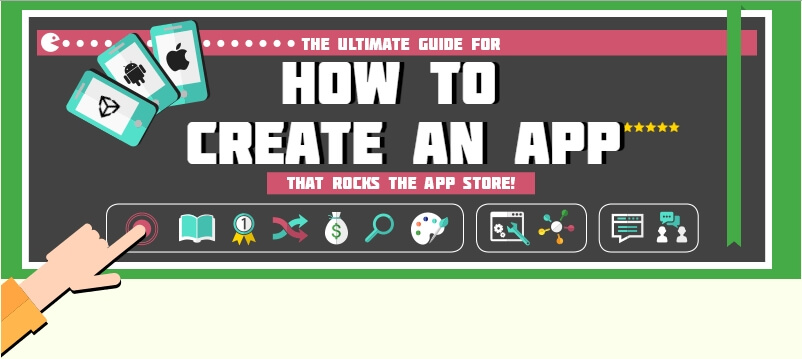

How to
Create an App


How to
Create an App
When it comes to apps, marketing at the very least lets people know that yours exists. And great app
marketing makes people want to download your app without a moment’s hesitation.
Unfortunately marketing is often an afterthought or, worse, completely ignored by many app developers.
But this is a huge mistake. The biggest app development companies have
entire marketing teams dedicated to promoting their apps.
Whereas smaller developers spend a median of $25 a month on marketing, as Matt Asay, a veteran technology
columnist, stated in his review of a study conducted by vision mobile.
Despite the crowded market, app marketing is a tiny
share
of developer budgets
Whilst the amount of money spent doesn’t necessarily reflect the quality and effectiveness of marketing strategies (indeed we will show you some fantastic cost-effective marketing strategies below) such a small figure does indicate a lack of marketing awareness by smaller developers. It is also indicative of the common problem of marketing on a shoestring budget while an entrepreneur is bootstrapping a venture.
In order to compete, app developers need to take marketing seriously. In fact, as highlighted in
MobiDev’s blog post here, poor marketing is often listed as one of
the biggest reasons apps fail.
To help overcome this challenge, here’s our list of cost-effective marketing essentials that no app
developer can afford to ignore.
In order to rank highly on app distribution platforms, apps need to achieve a high number of downloads
within 72 hours of their launch. So, if you’re aiming for a spot on the top ten list, you need to make
sure you get an initial boost.
Achieving a top ranking on any distribution platform can
significantly increase your amount of users, since your app will be displayed very publicly and receive
implicit endorsements from your chosen distribution platform.
One way of getting such a boost is to pay for installs. Because, using this technique, you effectively
secure a certain number of installs, so long as that exceeds a certain threshold, you can expect to see
an even larger number of organic installs follow.
According to data from Trademob, each paid install results in 0.9 organic installs (or a 90 percent
boost) in the days following the paid install. When it comes non-gaming apps, the result of one paid
install is 0.6 organic installs (or a boost of 60 percent).
So, for both gaming and non-gaming apps, by investing in
paid installs, it’s possible to significantly increase your app’s ranking.
However, though the benefit of purchasing installs can be great. In order to achieve a top ten ranking, you’re going to need a large budget. To put it into some perspective, to secure a top ten ranking on the Apple App Store you need:
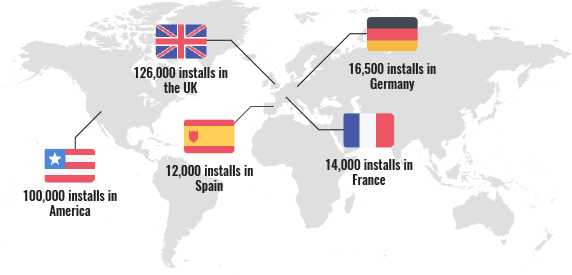
With an average cost of $1 per paid install, these numbers soon equate to a large marketing budget. If you can afford to pay for installs, it will almost certainly pay off. If not – well, that’s what the rest of this chapter’s for.
The number of downloads you receive immediately following your launch will typically form a bell curve. Downloads are usually low on the first day, then, on days two and three, this number will generally increase. After this boost, downloads will drop again – typically to the number you can expect to receive moving forward.

Of course, the more downloads you receive initially, the more you can expect to receive when at your
curve’s peak – and the more you can expect to receive from then on.
This means, if you’re happy with launch day’s downloads, then you can be confident that your app is
going to do well. Conversely, if you’re not satisfied with the number of downloads you get on launch
day, you’re not likely to be satisfied with your app’s performance from then on.
To make sure your app gets a high number of initial downloads, the rest of this chapter will detail some
great, cost-effective marketing options that
will make sure your
app is seen and installed.
App localisation is a technique that makes the most of the proliferation of smartphones all over the
world. The Apple App Store supports 28 languages, and Google play supports 46. Indeed, the purpose of
app
localisation is to make the most of local markets, without actually needing to change your app. In his great
article about app localisation, Patrick Yip stresses that for most first time developers,
Minimal Viable Localisation (MVL) is the best way into app localisation. MVL involves
localising your app store description for different global markets without actually translating the app
itself.
MVL has the benefit of being quick and cost-effective, and should give you an idea of what markets are
worth exploring further.
Translating your description into 10 languages should cost you less than $1,000. By using sites such as
Elance and Upwork you will be able to find
high-quality translators willing to translate your description for £30-80 (depending on the translator’s
experience and the language being translated to). This process should take around 1-2 days, including
proofreading and editing.

Never machine translate. It’s tempting to do this since the process is normally free and instant, but the quality is usually incredibly low.
When selecting which languages you wish to translate your description to, you need to take into account whether your demographic is prevalent in the countries that speak that language, whether your app will be valuable in countries that speak that language, and
how much disposable income people generally have in those countries.
Ievgen Leonov, A tech geek and the owner of Today’s Web blog provides an excellent overview of the top
10 languages that you should localize your app for.
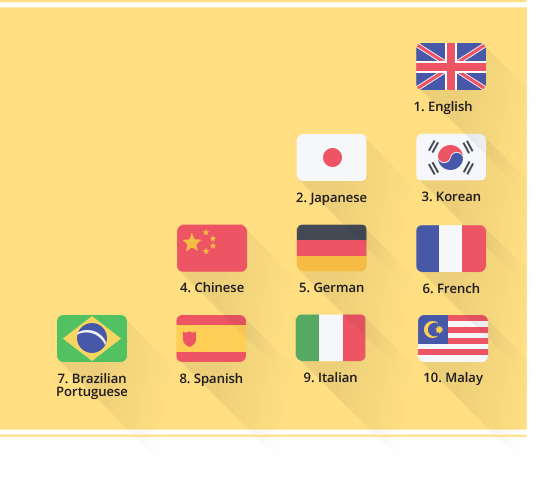
Through his findings and based on the number of projected downloads for each country the top 10 recommended languages for localisation are:
Before committing to a specific language, it’s worth carrying out research to see if you have any
competitors using that language. If there’s already a successful app doing what you do, it may be better
to opt for a different language. If you opt for MVL, make sure you mention that the app itself is in
English, since failing to do this may lead to negative feedback and poor reviews.
If you’re interested in MVL, localisation company ibabble provides a free cost estimator. Simply upload
your strings to the fee
generator and the company will give you a no-strings-attached quote. Of course, you can also opt
for Full Localisation, which involves translating
your entire app. However, this is a much more expensive and time consuming process – requiring changes to
your code and design. As such, our recommendation is to use MVL to find your most promising markets
before, if you so choose, fully localising your app.
Dom Bracher Co-Founder & CMO at Tapdaq provides invaluable information in his post about app localisation. He advises us that although this is
“not a straightforward or quick process”, there is a big opportunity for western developers: “41% of
global mobile revenue is generated in China, Japan and South Korea alone, and this is simply too greater
amount of money to be ignored.”
Like installs, reviews and ratings are an important factor in determining your ranking on your chosen app distribution platform. It’s a good thing, then, that there are ways to increase the number of ratings and reviews you get.
Getting off the ground in terms of ratings is something of a paradox. You need them in order to get
spotted, but without getting spotted, it’s hard to get them. So, to get the ball rolling ask everyone
you know – friends, family, colleagues – to rate your app. This should give your ratings an initial
boost.
But you’ll need
more than this.
If you have a social media following, it’s always worth putting the word out that you’d appreciate being
rated. And, since your followers will consist of people who already like your app, these are likely to
be high. Another method is to use in-app pop-ups to get reviews. If you’re developing for iOS, these can
be added to your
app using Appirater
or iRate. These are bits of open source code that can be easily integrated with
the rest of your app’s source code in order to enable ratings pop-ups. Appirater is
also available for Android.
You can configure these
pop-ups in different ways.
Caroline Lee, Community developer at Polljoy, provides great advice in her article about how to
improve your app store rating. For example, you can give users a “yes/no” option to give you a
five star rating. This has the benefit of boosting your chances of five star ratings, but may put off
others (even if they’d give your four stars!)
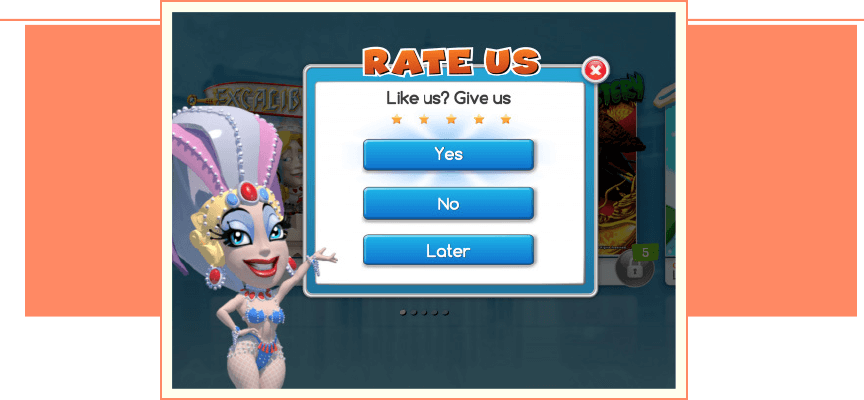
Kerry Butters provides some useful advice on how to encourage users to rate your app in her
post on getappcase. For example : you can ask users to “tap a star”……
You can ask users to “tap a star” to rate. This has the benefit of accruing as many ratings as possible, but
makes it just as easy to leave a one star rating as a five star one.

Or, as Kerry Butters also advises, you can simply request a rating. This is a more vanilla approach; but if you’re confident in the quality of your app, there’s no reason why it can’t be effective.
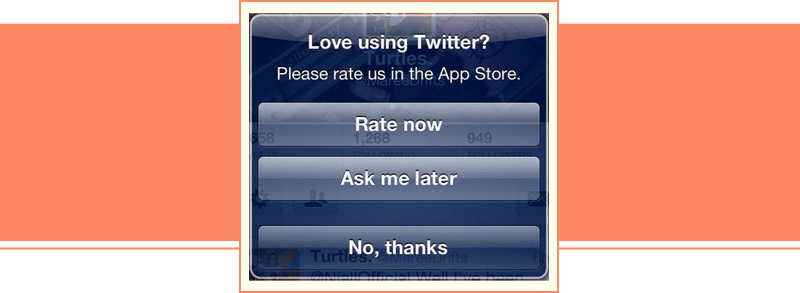
Because reviews take a little more time for users to complete than ratings, you can expect to get fewer of
them. In general, people who leave reviews will either be incredibly happy about your app, or incredibly
disappointed.
The quality of your app will play a large role in how many positive reviews you receive. That said, there
are some ways to incentivise users to leave them, as follows.
The best route to a positive app review is by providing exceptional customer service. If people feel that
they have had their problems or queries taken seriously then, even if their initial reason for getting
in contact was negative, they may still leave a positive review.
Helpshift is a free two-way
instant messaging window that can be integrated in your app in order to allow you to communicate
directly with users. By exchanging one-to-one messages with users, you can carry out very personal
dialogue that should prevent users leaving bad
reviews and, if it seems appropriate, allow you to request a positive one.
Steve P. Young provides five clever ways to increase mobile app reviews in his post
on kissmetrics, in which he cites contests as a great example:
You can also elicit reviews by running a contest. Touch Arcade, for example, has a
section where developers can run contests and giveaways to encourage other users to review their apps.
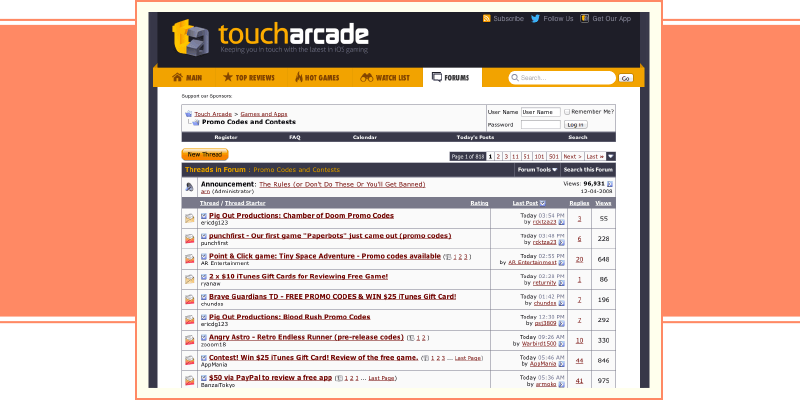
Reviewers will leave their iTunes or Google Play usernames as replies within your thread so that you can
randomly select a winner.
If you choose to run a contest, it’s important that you are completely
transparent when it comes to how your contestants can enter and how you will select a winner.
Social media is one of the most cost-effective and efficient marketing platforms. It can be used to
generate interest and downloads no matter how high or low your budget is.
Sam Hutchings from Tapdaq presents the “viral loop” as a highly effective technique that can really
boost the interaction of users with your app in his excellent post
about it.
Social media management can become a complicated process, involving multiple accounts, content creation, and platform-specific advertising. One of the best ways to structure your approach to social media is to use the concept of the viral loop.
The viral loop consists of the steps a user goes through between installing an app and inviting other users to join them. It is made up of four stages: seeing, installing, having a desire to share, and, ultimately, sharing.
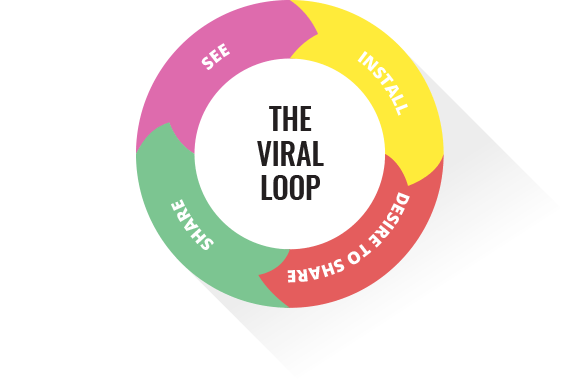
If it is implemented well, the viral loop can create a snowball effect of increased downloads, awareness and
revenues for your app in just a matter of weeks.
The most important stages of the viral loop are
the “seeing” stage and the “desire to share stage”.
Developer company Ketchapp used an easy Twitter sharing function so that users can share their Ball Jump scores on social media. With a click of a button, players share a tweet following the format illustrated below.

Users are invited to share their score with the hashtag #BallJump when the game is over to generate and
spread interest in the game. The tweet also contains a link back to iTunes, so that any potential
players can easily find the game to download. It is a simple mechanism that makes it fantastically easy
to ramp up brand awareness, boost downloads and spark social media buzz.
This approach led to three desired results:

You can find out more about Ball Jump’s approach to the viral loop
here. Ball Jump peaked
the charts in 12 countries after its release, proving that the viral loop is an essential component of
an overall successful marketing strategy. In fact, the technique is so effective that many other games
are implementing the same strategy.
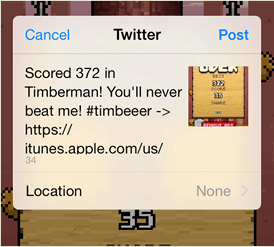
An example of a sharing invitation in Timberman from Sam Hutchings’ post on apptamin that we referenced earlier.
Depending on the nature of your app, you’ll want to focus on certain social networks in order to make sure people see your app. Since Facebook and Twitter are the largest social networks, with the most varied user demographics, every app should have a presence on at least these sites. However, if you’re releasing a game, then a YouTube account, where you can post videos and tutorials of your game in action, may be a good
idea. Or, if your app targets business people specifically, then setting up a LinkedIn Company Page would
make more sense.
But remember, the more accounts you have, the more time you’ll have to spend updating them and
monitoring them, so think carefully about what you can realistically commit to.
Refer back to Chapter 4, Conducting Niche Research, as this will help you understand how to determine which social networks would be more appropriate for your particular app.

Sproutsocial have a great breakdown of the demographics on all of
the biggest social media sites. So be sure to check that out before deciding which ones to focus on. The
key to all good social media is good content. Good content carries a significant value – it gives your
followers something, whether that’s a quick chuckle or a detailed overview of your industry. Social
media sites are not the place to barrage your followers with your latest discounts and offers (in fact,
according to SocialMediaToday, only 20 percent of your content
should be about your brand.)
Instead, use the knowledge you gained when you were carrying out your initial market research (again,
refer back to Chapter 4 for this) to post content that you know will appeal to your audience. Focus on
their interests, passions, wants, and desires. Cater for their needs, and not for yours. The customer
comes first, always, after all.
And everything you post doesn’t have to be original. There’s nothing wrong with sharing news stories,
videos, images, or any other content from reputable third-parties. Indeed, this is an excellent way of
varying your content (thereby preventing your brand from being self-serving by broadcasting your own
content and also preventing you from being too ‘salesy’ in your approach, which is a big turn-off) and
also demonstrating that you have your finger on the pulse for what is going
on in your niche or sector. In order to manage all of the content you plan to put out, it’s a good idea to create a content calendar. Here you can plan what you’re going to post and when, giving you ample time to create your own content and gather content from elsewhere.
You can either:
The second crucial part of the viral loop is the “desire to share”.
Only once your users start sharing does the viral loop kick in, since some of the people they share your
app with will download it and share it with others. This means you have to make sharing as beneficial as
possible.
Whilst it’s true that people like sharing things online, this often doesn’t include apps. Therefore,
it’s important to introduce incentives to encourage people to share
your app. Incentives can be as simple as offering the user the opportunity to share their successes on
the app – this works especially well for fitness apps, intellectual games, or any other apps which
contain data people may be proud of.
If your app does not contain this sort of data, offering users in-app rewards (such as a “sharing
badge”, extra power-ups, points, or some other benefit) or real-world rewards may be necessary in order
to win them over.
You’ve probably heard of Candy Crush Saga. Not least because you’ve probably been on the receiving
end of the game’s users’ desire to share!
The game has been incredibly successful at making players invite their friends for help when they
get stuck. Most commonly, this takes the form of Facebook invites, whereby the player gets
additional items to help them when their friends join the game.
The game capitalises on its own difficulty and addictiveness to elicit a desire to share in its
users. And it works: the game is the most downloaded app for iOS ever!

Plenty of sites exist that review apps. These often have thousands of followers, and so coverage from them can help generate exposure for your app. We’ve compiled a list of 267 sites where you can submit your app for review:
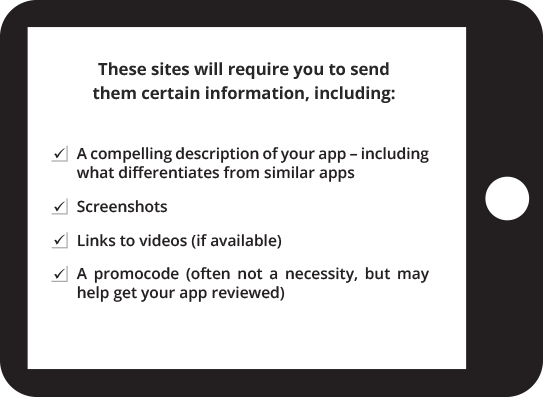
In addition to this, you will want to create a web front for your app. This is because many review websites
may ask for links to the app’s official website, Facebook page, or Twitter page.
For some inspiration, take a look at
these 30
great app websites.
As well as sending your website and social media profiles to review sites, you can also publish your app homepage and preview videos to indie developer Facebook groups. The groups offer mutual support for apps by exchanging ratings and reviews as well as sharing each other’s apps. Indeed, we have compiled a list of 54 groups for mobile developers on Facebook and LinkedIn so you can leverage this important resource quickly.
Guru Erik Qualman leaves us with these final thoughts:
Marketing is essential. If you neglect this strategic business imperative, then your app will struggle…or even fail. It is about promoting it in such a way that you maximise the app’s exposure, create buzz and excitement, and trigger a snowball effect. This marketing chapter outlines tried and tested methods to give your app the
very best chance of success, without having to spend big bucks. From app localisation techniques, the viral loop, and WOM (Word of Mouth), to giving your app a timely boost by paying for installs, this is where you can make a huge difference to your app’s launch and ongoing success.